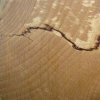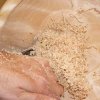Says you're a cheesehead, so I'll assume that you're not talking about a tree whose common name is green birch, rather one of the common "yellow" birches like B nigra, lenta or alleghaniensis (leutea), or "white" B papyrifera in an unseasoned state. White birch is lower in density, less prone to grain reversals and lacks the dark heartwood of the commercial yellows. It's the stuff of golf tees and wooden thread spools, and behaves pretty well under the tool because of its straighter grain. It looks, smells and tastes like Popsicle sticks and tongue depressors, because they were traditional uses for the wood.
The yellows go a lot to grain reversals, making them fun to split as firewood, and providing surprise areas where your tool is prone to pick up some fibers if you tool isn't in perfect peeling position. Doesn't scrape worth squat, either, for the same reason, and if you're using it in flat work, gives blotchy results with stains. They can get really wild, producing "flame" figure, which is especially difficult to cut.
I don't approach them as Steve does, with an edge up into the rotation, because it will pull those reversed places. I take a broad forged gouge, tilt it up on its edge and move across the general direction of the fiber, allowing the rotation of the piece to slide it down the edge of the gouge. When the wood is green, I broaden the face of the cut, producing wide shavings. For dry wood, broader-faced cuts would make pickup of wild grain more likely, so I keep it very narrow. You can see by this closeup of the outside of a bowl that it leaves closely-spaced concentric lines rather than a smooth surface, but there is minimum pickup in the climb cutting zone near the top of the picture. For the inside, the gouge position is pretty much the same as the outside, making for narrow shavings.
It's great wood to look at, but you have to be pretty careful to cut rather than pick up or scrape, because it's less forgiving then something with shorter, more uniform grain like cherry or maple.


